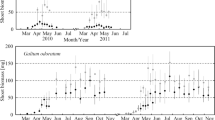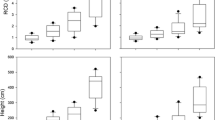Abstract
A synchronic method was applied in order to investigate the growth process of the dominant woody plants in an undisturbed Mediterranean evergreen-sclerophyllous ecosystem in central Greece. Cover (%), biomass and leaf area data of Arbutus unedo, Erica arborea, Quercus coccifera and Phyllyrea latifolia over a period of 30 years are provided. The investigation of growth by means of the Richards function revealed two plant groups, following two different growth strategies: A ‘fast growth’ strategy, followed by A. unedo and E. arborea and a ‘slow growth’ strategy followed by Q. coccifera and P. latifolia. Furthermore, a succession pattern was described in which the fast growing initial dominants are being replaced by the slow growing plants. Two succession scenaria are proposed as alternative plant responses to grazing and fires, which are the major anthropogenic impacts in the mediterranean environment.
Similar content being viewed by others
References
Aerts, R. 1990. Nutrient use efficiency in evergreen and deciduous species from heathlands. Oecologia 84: 391–397.
Aerts, R. & van der Peijl, M. J. 1993. A simple model to explain the dominance of low productive perennials in nutrient poor habitats. Oikos 66: 144–147.
Berendse, F., Oudhof, H. & Bol, J. 1987. A comparative study on nutrient cycling in wet heathland ecosystems. I. Litter production and nutrient losses from the plant. Oecologia 74: 174–184.
Biswell, H. H. 1974. Effects of fire in chaparral. In: Koslowsky, T. T. & Ahlgren, C. E. (eds), Fire and Ecosystems. Academic Press, New York.
Coley, P. D., Bryant, J. R. & Chapin, F. S. 1985. Resource availability and plant antiherbivore defence. Science 230: 895–899.
Diamandopoulos, J. 1983. Structure distribution and origin of the Greek Fryganic Ecosystems. Ph. D. Thesis, Univ. of Thessaloniki. In Greek with an English summary.
Ellner, S. 1987. Alternate plant life history strategies and coexistence in randomly varying environments. Vegetatio 69: 199–208.
Grime, J. P. 1977. Evidence for the existence of three primary strategies in plants and its relevance to ecological and evolutionary theory. American Naturalist III: 1169–1194.
Grime, J. P. 1986. Plant strategies and vegetation processes. 4th Edition. John Willey & Sons Ltd, Chichester.
Grime, J. P. 1988. The C-R-S-model of plant primary strategies-origin implications and tests. In: Gottlieb, L. d. & Jain, K. S. (eds). Plant Evolutionary Biology. Chapman & Hall, London.
Grime, J. P. & Hunt, R. 1975. Relative growth rate: its range and adaptive significance in a local flora. J. Ecol. 63: 393–422.
Jones, G. 1979. Vegetation productivity: Topics in applied Geography. Longman, London-New York.
Hilbert, D. W., Swift, D. M., Detting, J. K. & Dyer, M. I. 1981. Relative growth rates and the grazing optimisation hypothesis. Oecologia 51: 14–18.
Hunt, R. 1978. Plant Growth Analysis. Studies in Biology 96. Edward Arnold Ltd., London.
Hunt, R. 1982. Plant Growth Curves: The Functional Approach to Plant Growth Analysis. Edward Arnold Ltd., London.
Kokkinidis, G., Efthymiou, P. N. & Eleftheriadis, N. 1984. Forestry in Greece. Balkan Scientific Conference on Exploring, Preserving and Utilisation of Forest Resources. Sofia, Bulgaria.
Kummerow, J. 1973. Comparative Anatomy of Sclerophylls of Mediterranean Climatic Areas. In: Di Castri, F. & Mooney, H. A. (eds), Mediterranean Type Ecosystems. Springer Verlag, New York.
Le Houerou, H. N. 1973. Fire and Vegetation in the Mediterranean Basin. Proc. 13th Ann. Tall Timbers Fire Ecol. Conf., pp 237–277. Tallahassee, Florida.
Liacos, L. 1982. Grazing management of evergreen brushlands in Greece. Proc. of the Symposium on ‘Dynamics and Management of Mediterranean-Type Ecosystems’. San Diego State University, San Diego, California.
Minich, A. R. 1982. Grazing, Fire and Management of Vegetation of Santa Catalina Island, California. Proc. of the Symposium on ‘Dynamics and Management of Mediterranean-Type Ecosystems’. San Diego State University, San Diego, California.
Mooney, H. A. & Parsons, D. J. 1973. Structure and Function of the California Chaparral — an Example of San Dimas. In: Di Castri, F. & Mooney, H. A. (eds), Mediterranean Type Ecosystems. Springer Verlag, New York.
Mooney, H. A. & Dunn, E. L. 1976. Convergent evolution of Mediterranean climate evergreen sclerophyll shrubs. Evolution 24: 292–303.
Mooney, H. A. 1977. Convergent Evolution in Chile and California. Dowden Hutchinson and Ross, Pensylvania.
Nacos, G. 1977. General Geological Map of Greece. Ministry of Agriculture, Institute of Forest Research, Athens.
National Meteorological Service. 1985. Meteorological Yearbook of Greece, Athens.
Naveh, Z. 1974. Effect of fire in the Mediterranean Region. In: Kozlowski, T. T. & Ahlgren, C. E. (eds), Fire and Ecosystems. Academic Press, New York.
Naveh, Z. 1975. The evolutionary significance of fire in the Mediterranean region. Vegetatio 29: 199–208.
Oesterheld, M. & McNaughton, S. J. 1991. Effect of stress and time for recovery on the amount of compensatory growth after grazing. Oecologia 85: 205–313.
Paraskevopoulos, S. P. 1991. Study of regenerative process of mediterranean-type ecosystems in Greece after harvesting for energy and organics. Ph.D. Thesis, University of Aegean, Mytilene, Greece. In Greek with English Summary.
Parsons, D. J. 1976. Vegetation structure in the Mediterranean scrub communities of California and Chile. J. Ecol. 64: 435–447.
Parsons, D. J. & Moldenke, A. R. 1975. Convergence in Vegetation Structure along analogous climatic gradients in California and Chile. Ecology 56: 950–957.
Pollard, J. H. 1977. Numerical and Statistical Techniques with examples mainly from the life Science: A Handbook. Cambridge Univ. Press, Cambridge.
Quezel, P. 1981. Floristic composition and phytosociological structure of sclerophyllous matorral around the Mediterranean. In: Di Castri, F., Goodall, D. W. & Specht, R. L. (eds), Ecosystems of the World. II, Mediterranean-type shrublands. Elsevier Scientific Publ. Co., Amsterdam-Oxford-New York.
Rapp, M. & Lossaint, P. 1981. Some aspects of mineral cycling in the garrigue of Southern France. In: Di Castri, F., Goodall, D. W. & Specht, R. L. (eds), Ecosystems of the World. II, Mediterranean-type shrublands. Elsevier Scientific Publ. Co., Amsterdam-Oxford-New York.
Richards, F. J. 1959. A flexible growth function for empirical use. J. Exp. Bot. 10: 290–300.
Richards, F. J. 1969. The quantitative analysis of growth. In: Steward, F. D. (ed), Plant Physiology, Vol. 5A. Academic Press, London.
Southwood, T. R. E. 1988. Tactics, strategies and templets. Oikos 53: 3–18.
Specht, R. L. & Moll, E. J. 1983. Mediterranean-Type Heathlands and Sclerophyllous Shrublands of the World: An Overview. In: Kruger, F. J., Mitchell, D. T. & Jarvis, J. U. M. (eds), Mediterranean-Type Ecosystems. The Role of Nutrients. Springer Verlag, Berlin.
Tilman, D. 1988. Plant Strategies and the Structure and Dynamic of Plant Communities. Princeton University Press, Princeton.
Tilman, D. 1990. Constraints and trade-offs: toward a predictive theory of competition and succession. Oikos 58: 3–15.
Trabaud, L. 1981. Man and Fire: Impacts on Mediterranean Vegetation. In: Di Castri, F., Goodall, D. W. & Specht, R. L. (eds), Ecosystems of the World. II, Mediterranean-type shrublands. Elsevier Scientific Publ. Co., Amsterdam-Oxford-New York.
Author information
Authors and Affiliations
Rights and permissions
About this article
Cite this article
Paraskevopoulos, S.P., Iatrou, G.D. & Pantis, J.D. Plant growth strategies in evergreen-sclerophyllous shrublands (Maquis) in central Greece. Vegetatio 115, 109–114 (1994). https://doi.org/10.1007/BF00044865
Accepted:
Issue Date:
DOI: https://doi.org/10.1007/BF00044865




